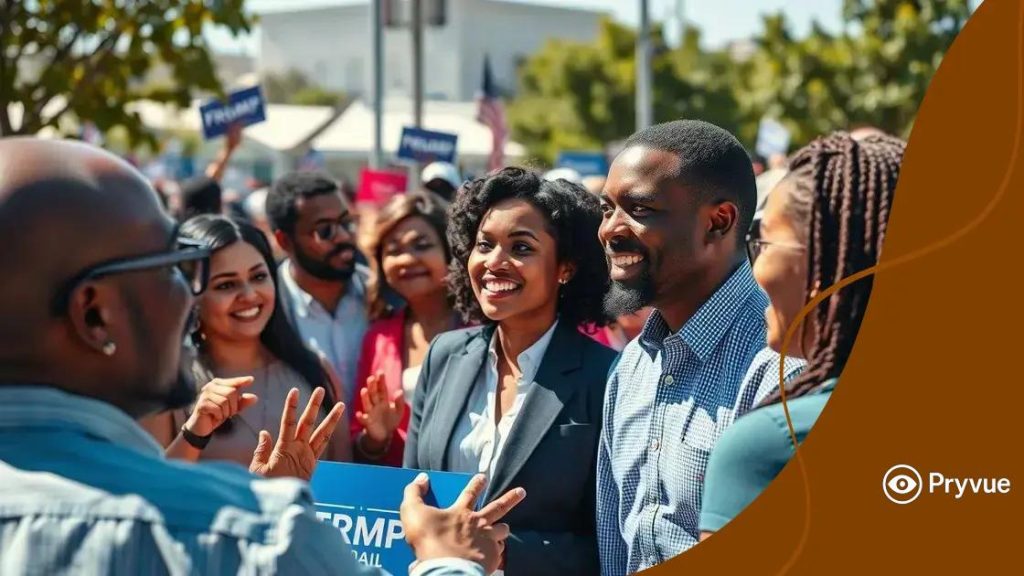2026 midterm election candidates to watch out for

Anúncios
The 2026 midterm election will be substantially influenced by key issues such as healthcare access, climate change, and economic recovery, while social media plays a pivotal role in increasing voter engagement and turnout.
The 2026 midterm election candidates are already garnering attention as they prepare for a pivotal role in shaping future policies. Curious about who to watch? Let’s dive into the prominent figures and trends that could redefine our political landscape.
Anúncios
Main candidates for the 2026 midterm election
The 2026 midterm election is gearing up to be an eventful time in politics. Various candidates are emerging, each with unique platforms and goals. Understanding who these candidates are is vital for voters looking to make informed decisions.
Key Candidates to Watch
This election features candidates from various backgrounds and political affiliations. Here are some of the main figures to keep an eye on:
- Candidate A – Known for their strong stance on environmental issues.
- Candidate B – A seasoned politician focusing on healthcare reform.
- Candidate C – A newcomer promising fresh perspectives on education.
- Candidate D – A popular figure advocating for economic growth and infrastructure development.
Each of these candidates brings distinct ideas to the table. Candidate A, for instance, emphasizes the importance of addressing climate change head-on. They propose innovative policies to transition to renewable energy. Meanwhile, Candidate B aims to tackle the rising costs of healthcare and improve access to services for all citizens.
Anúncios
Candidate C represents a shift in voter sentiment, appealing particularly to younger demographics seeking change. Their initiatives involve enhancing public schooling and making college more affordable. In contrast, Candidate D’s campaign revolves around rebuilding the nation’s infrastructure, which they believe is crucial for economic recovery.
As these candidates build their campaigns, endorsements and public support will play significant roles in shaping the election landscape. Observers should pay close attention to how each candidate interacts with voters on social media and at public events. These interactions can provide insights into their overall appeal and strategies.
Voter Reactions and Trends
Public opinion is also critical. Candidates who can resonate with the electorate’s concerns may find themselves in a stronger position. For now, it is essential to track how candidates refine their messages and address pressing national issues.
By diving deeper into who the main candidates for the 2026 midterm election are, voters can better understand the upcoming political landscape and prepare for the choices ahead.
How candidates are selected in the US
Understanding how candidates are selected in the US is essential for grasping the political process. The selection process varies by party and local regulations, but it typically follows a series of defined steps.
Candidate Nomination Process
The candidate nomination process often begins at the state level, where potential candidates must meet certain criteria. Here are the basic steps:
- Candidates announce their intent to run for office.
- They must gather a specific number of signatures to qualify for the ballot.
- Candidates then file paperwork, including financial disclosures, with the appropriate election office.
- Once qualified, they can campaign for their party’s nomination.
During this phase, candidates engage in various activities, from hosting events to participating in debates, to gain visibility. Public opinion plays a significant role, as candidates must appeal to their party members to gain support.
Primaries and Caucuses
The next critical stage is primaries and caucuses. These events allow party members to vote for their preferred candidate. In some states, primaries are closed, meaning only registered party members can vote, while others allow open primaries where any registered voter can participate.
These events are crucial as they determine which candidates will represent the party in the general election. Candidates who perform well in these early contests gain momentum and can attract more funding and endorsements.
After the primaries conclude, party conventions are held. Delegates gather to formally nominate their candidate for the general election, solidifying the party’s choice.
The candidate selected will then prepare for the general election, focusing on broader issues to appeal to a wider audience beyond their party. This phase also involves selecting a running mate, known as a vice-presidential candidate, to balance the ticket and appeal to more voters.
Impact of social media on campaigns

The impact of social media on campaigns has transformed the political landscape. Candidates now leverage platforms like Twitter, Facebook, and Instagram to connect with voters. This shift allows for instant communication and widespread outreach.
Direct Engagement with Voters
Social media permits candidates to engage directly with their audience. They can respond to questions and concerns quickly. Here are some crucial benefits of this engagement:
- Real-time feedback helps candidates adjust their messaging.
- Voters can share their thoughts, making the process more interactive.
- Campaigns can use social media to mobilize supporters for events and rallies.
This direct interaction fosters a sense of community and allows voters to feel more connected to the candidates. Campaigns can showcase personal moments that highlight their personality and values.
Targeted Advertising
Social media also allows for targeted advertising. Campaigns can tailor their ads based on demographics, interests, and behaviors. This means that:
- Specific messages can reach particular groups, making them more effective.
- Advertising costs can be controlled, maximizing budget efficiency.
- Data analytics help campaigns evaluate ad performance and adjust strategies.
Candidates have the ability to create ads that resonate with various voter segments. For instance, younger voters may be targeted with issues related to education and climate change, whereas older voters might respond better to topics involving healthcare and security.
As the public becomes more engaged online, the importance of social media in campaigns increases. Candidates who can effectively navigate these platforms often have an edge over their opponents. Social media not only impacts how candidates communicate but also shapes public perception and influences voter decisions.
Key issues shaping the 2026 election
The key issues shaping the 2026 election play a crucial role in determining which candidates resonate with voters. As the election approaches, several areas of concern have emerged that candidates will need to address.
Healthcare Access and Affordability
One of the most pressing issues is healthcare. Voters are increasingly concerned about access to affordable healthcare. Candidates must present clear plans on how to improve the current system. Here are some important aspects:
- Reducing prescription drug prices to ensure affordability.
- Expanding access to mental health services.
- Improving coverage for pre-existing conditions.
These topics are especially important for families and individuals who worry about medical expenses affecting their financial stability.
Climate Change and Environmental Policies
Climate change remains at the forefront of many voters’ minds. Issues regarding environmental policies will likely dominate discussions during the campaign. Candidates who prioritize sustainability and propose actionable plans may attract environmental advocates.
Key points include:
- Investing in renewable energy sources.
- Implementing stricter regulations on pollution.
- Promoting green jobs and initiatives to boost the economy.
These initiatives are vital for encouraging a healthier planet and fostering economic growth simultaneously.
Economic Recovery and Job Creation
As the nation aims to recover from economic downturns, job creation will also be a critical topic. Candidates will focus on how they plan to create jobs in various sectors.
Voters will look for:
- Investment in infrastructure projects.
- Support for small businesses and entrepreneurship.
- Educational programs that prepare workers for future jobs.
This focus on economic recovery will continue to shape the conversation as candidates propose solutions to enhance the workforce and overall economy.
Addressing these key issues effectively will be crucial for candidates as they strive to win the support of a diverse electorate in the upcoming 2026 election.
Predictions for voter turnout and engagement
Predictions for voter turnout and engagement in the 2026 elections are crucial for understanding how the political landscape may shift. As the election approaches, analysts focus on various factors that could influence turnout, especially among young voters.
Historical Trends
Looking at historical voting patterns helps to forecast what might happen. In previous elections, voter turnout has fluctuated based on the issues at stake. Key trends include:
- Higher turnout in presidential election years compared to midterm elections.
- Increased engagement among younger voters when issues like climate change and healthcare are prominent.
- Impact of major social movements which can motivate participation.
These patterns indicate that engagement may rise if voters feel strongly about the candidates and issues presented.
Influence of Digital Campaigning
The role of digital campaigning cannot be underestimated. Social media initiatives have the potential to energize voters. Campaigns that utilize digital platforms effectively often see higher engagement rates. Components of successful digital campaigns include:
- Interactive content that encourages shares and discussions.
- Targeted ads that reach specific demographics.
- Live events and Q&A sessions where candidates interact with voters.
These strategies create a two-way conversation and can significantly boost voter interest.
Key Demographics
Engagement is expected to increase among specific demographics. Factors influencing this include:
- Young voters, who are becoming increasingly motivated to participate due to pressing global issues.
- Minority groups, who may feel more empowerment to vote as representation increases.
- The importance of local elections that directly impact their communities.
By focusing on these groups, campaigns can develop tailored strategies to enhance turnout.
As the election date approaches, organizations are ramping up efforts to mobilize voters. By understanding these predictions and trends, candidates can better connect with their electorate.
In conclusion, the 2026 election will be shaped by essential issues that matter to voters. Understanding key topics such as healthcare, climate change, and economic recovery will be crucial for candidates. Additionally, engaging young voters through social media and community outreach can make a significant impact on turnout. By addressing these concerns and connecting with the electorate, candidates can enhance their chances of success in the upcoming election.
\n\n
\n
FAQ – Questions about the 2026 Election Candidates and Voter Engagement
What are the key issues influencing the 2026 election?
Key issues include healthcare access, climate change, and economic recovery, which are vital for attracting voter support.
How does social media impact voter engagement?
Social media helps candidates connect with voters, allowing for direct interaction and tailored messaging, especially for younger demographics.
Why is voter turnout expected to be higher in 2026?
Voter turnout may increase due to heightened awareness and engagement driven by pressing issues and effective campaigning strategies.
What role do historical trends play in predicting voter behavior?
Historical trends show patterns of voting behavior that can help predict future turnout based on various factors like major social movements and issues.